When your beloved canine friend greets you at the door, wiggling with pure joy and a tail wagging vigorously, you instinctively understand their happiness. Similarly, a tucked tail and wide eyes clearly signal distress. However, are you attuned to the more subtle shifts in body language that precede these overt displays of emotion? Learning to recognize these nuanced signals is key to truly understanding The Secret Language Of Dogs.
As experts in animal behavior, part of our role is to interpret these subtle changes in body language that indicate shifts in an animal’s emotional state. Most animals do not escalate from calm to extreme distress or aggression instantly; they typically begin with lower-level signals to communicate their feelings long before resorting to snapping, snarling, fleeing, or hiding. The challenge lies in recognizing and responding appropriately to the whispers in your animal’s behavior, thereby preventing their overstimulation to the point where they feel compelled to scream.
Why Understanding Dog Body Language is Crucial
The ability to decipher the body language of our cherished furry friends allows us to better comprehend their feelings, desires, and needs. This understanding profoundly enhances our capacity to care for and provide for them. Moreover, recognizing animal behavior is fundamental to keeping ourselves and the animals in our lives safe. Picking up on an animal’s body language is especially important in settings where animals may have no known behavioral history. While each dog is an individual with unique quirks, there is significant behavioral consistency within the species. By learning to read these commonalities, we can better understand their inner emotional worlds and respond appropriately to what they are telling us, strengthening our bonds and fostering greater harmony. For further insights into canine behavior and training, consider exploring resources on the dog training secret.
A Holistic Approach to Interpreting Dog Behavior
When observing and interpreting animal behavior, it’s essential to adopt a holistic perspective rather than focusing on isolated cues. This comprehensive view helps in accurately understanding your dog’s true emotional state and intentions.
Observe the Entire Body
While the position of a dog’s ears or tail can offer important clues, it is crucial to consider their entire body to gain a complete understanding of what they are communicating at any given moment. A tail wag alone, for instance, doesn’t always mean happiness; its context with the rest of the body provides the full picture. Look at everything from their eyes and mouth to their posture and weight distribution.
Context is Key
Behavior never occurs in isolation. The same behaviors can have vastly different meanings depending on the situation. Carefully observing the context in which behaviors occur will significantly help you gain a better understanding of what an animal is trying to tell you and why. For example, lip licking could indicate stress in a novel environment, but simply a desire for a treat after a meal.
Every Dog is an Individual
An animal’s behavior is influenced by numerous factors that can vary widely from one individual to another. Learning their history, level of socialization, health status, breed, age, and genetics are just a few examples of variables that can affect how a dog behaves in a given situation. What might be a sign of discomfort for one dog could be a normal expression for another. Always consider your dog’s unique personality and background when interpreting their signals.
Green, Yellow, and Red Light Behaviors: A Guide to Dog Communication
As animal behavior professionals, we frequently encounter the misconception that a dog “attacked out of nowhere.” While it may appear sudden, animals very rarely bypass milder warning signs and proceed directly to snapping, scratching, or biting. In the rare instances where dogs truly show little to no warning, it’s often because their subtle signals have been ignored or even punished in the past. This is akin to human communication; we might start with subtle hints, but if ignored, we escalate to more direct or forceful expressions.
Understanding the Traffic Light System
In the shelter environment, we often categorize behaviors into “green, yellow, and red light” signals, drawing an analogy to traffic lights. Green means “good to go,” yellow signifies “use caution, slow down,” and red means “stop!” These “red light” behaviors almost invariably occur when an animal’s “yellow light” behaviors are either overlooked or go unrecognized. Green and red light behaviors are generally the easiest to spot as they represent the extremes of the behavioral spectrum.
For example, a dog with soft eyes, a loose, wiggly body, and an open, relaxed mouth is displaying ‘green light’ behaviors, indicating a desire to continue interaction. Conversely, a dog making direct, hard eye contact, growling, baring teeth, and shifting its weight forward is exhibiting red light behaviors, signaling that all interactions should cease immediately. A dog turning its head away, lowering its body, tucking its tail, licking its lips, or even raising a front paw is showing yellow light behaviors. These are attempts to communicate nervousness and a need for a break or a change in your behavior to make them more comfortable.
Green Light Behaviors
These are signs that your dog is relaxed, happy, and comfortable with the current situation or interaction. Understanding these cues helps reinforce positive experiences.
- Soft eyes
- Neutral pupils, not dilated
- Loose and wiggly body
- Indirect approach (when greeting)
- Attentiveness, approach, and seeking soft eye contact
- Frequently changing position (during play)
- Relaxed facial muscles, smooth forehead
- Slow blinks
- Helicopter or wide, sweeping tail wags
- Neutral or relaxed body, ears, and tail
- Play bows
- Body curved like a C
- Taking brief pauses during play (with other animals and humans)
- Bouncy, exaggerated movements
- Open and relaxed mouth (commissure pulled back, no wrinkles)
- Tongue lolling out
- Playful barking
- Normal panting
Yellow Light Behaviors
These signals indicate caution; your dog might be feeling nervous, stressed, or uncomfortable. It’s a call for you to slow down, observe more closely, and potentially modify your actions or the environment.
- Trembling
- Pacing
- Shaking off (as a stress relief mechanism, as if wet)
- Exit seeking (looking for an escape route)
- Displacement behaviors: Normal behaviors displayed out of context (e.g., intently sniffing ground, sneezing, yawning, lip licking, paw raise).
- Avoidance behaviors: backing away, turning head away, hiding
- Hair standing on end (piloerection – can also indicate arousal/excitement)
- Weight shifted back
- Body/facial tension
- Tucked or low tail
- Tucked limbs
- Low body posture
- Tension around eyes, resulting in wide or very tight and squinted eyes
- Fast and repetitive blinking
- Wide, round eyes
- Excessive drool (in abnormal contexts)
- Rapid panting (in abnormal contexts)
- Lip licking and tongue flicking
- Whale eye: sideways glance where much of the white in their eyes is visible, avoiding direct eye contact
- Dilated pupils
- Ears pinned back or flat against head
- Wrinkled forehead and facial tension
- Exposing belly (as a sign of surrender, not necessarily seeking belly rubs)
- Front paw raise
- Urinating (submissive or fear-based)
- Stress panting (tense, V-shaped mouth)
- Low and fast tail wags
- Submissive smile or grin
Red Light Behaviors
These are clear warnings that your dog is highly distressed, fearful, or ready to defend itself. All interactions should stop immediately, and the dog should be given space to de-escalate. Ignoring these signals can lead to bites or other aggressive actions.
- Fixed, direct, hard stare (eyes appear cold, flat)
- Rigid, frozen body posture
- Weight shifted forward (indicating readiness to engage)
- Very dilated pupils
- Biting
- Wrinkled nose
- Mouth closes suddenly with tension around the muzzle (often preceding a bite)
- Piloerection: hair on shoulders, back, and/or base of tail stands on end (can also be a sign of excitement but often indicates fear or aggression here)
- Growling, snapping, snarling
- High/flagged tail with fast, lateral wags
- Puckered commissure (corners of mouth)
- Ears rigid and pointed forward
- Lips pulled up and back, exposing teeth
- Tail, spine, and head in a straight line (rigid posture)
- Air snapping and head whipping
Deciphering Specific Dog Body Language Cues
Understanding individual body parts and their combined signals provides a more accurate picture of your dog’s emotional state.
Greetings: The Polite Approach
Humans often greet dogs in a way that can be perceived as rude in canine circles—frontally, with direct eye contact, extending a hand, bending over, or leaning in to pat their head. While this feels natural to us, it’s a major social faux pas for dogs. The “polite” way a well-socialized dog greets another canine is to approach from the side with a curved, loose body, avoiding direct eye contact, keeping eyes soft, and hands/paws to themselves unless the dog approaches and solicits interaction.
Hugs and kisses, as much as we love to give them, are generally considered rude by most dogs. While your own dog might tolerate an arm draped around their shoulder or a face pressed against theirs, this can be quite frightening for many dogs and create an unsafe situation. It is always more polite to approach a dog from the side, sit or kneel down, and never lean or loom over them. Giving your furry friends choice and control over interactions goes a long way in building trust. The curious incident of the dog in the nighttime book beautifully illustrates the complexities of understanding the world from a dog’s perspective, emphasizing the need for respectful interaction.
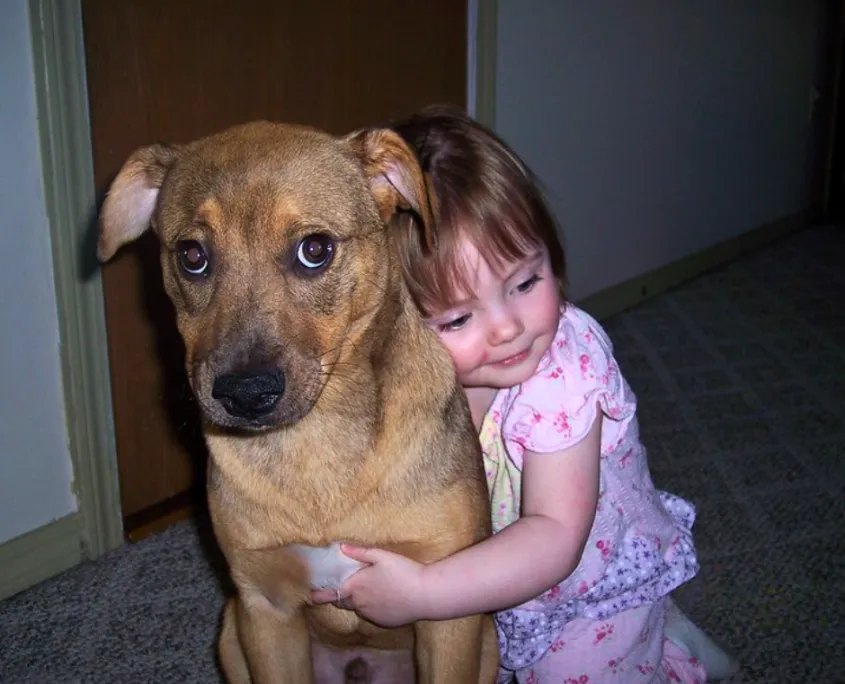 A young girl hugging a dog, who appears tense with a closed mouth, whale eyes, and is leaning away from the hug.
A young girl hugging a dog, who appears tense with a closed mouth, whale eyes, and is leaning away from the hug.
Eyes: Windows to the Soul
The shape, intensity, sheen, and direction of a dog’s gaze can convey a wealth of information about their current feelings.
Soft Eyes
When a dog is content and at ease, their eyes often appear “soft” and relaxed. These eyes are commonly almond-shaped or slightly squinty and are not accompanied by tension in the surrounding skin or a furrowed brow. Dogs with soft eyes are likely feeling happy, peaceful, and relaxed. They often exhibit other green light behaviors such as relaxed or neutral ears, a loose and/or wiggly body posture, sweeping tail wags, an open mouth, and/or a lolling tongue.
 Two dogs, one looking directly at the camera with soft, relaxed eyes, and another with similarly soft eyes, indicating contentment.
Two dogs, one looking directly at the camera with soft, relaxed eyes, and another with similarly soft eyes, indicating contentment. 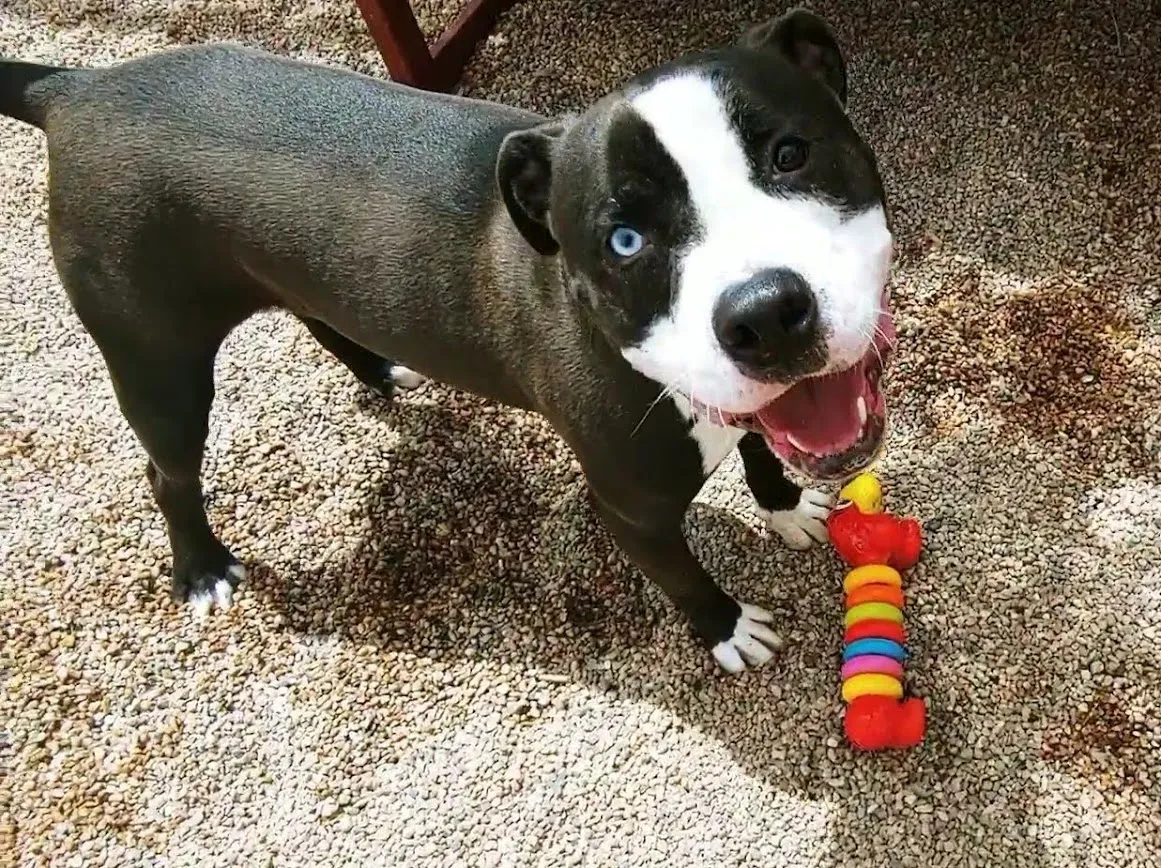 A dog with soft eyes and a relaxed facial expression, indicating a calm and content state.
A dog with soft eyes and a relaxed facial expression, indicating a calm and content state. 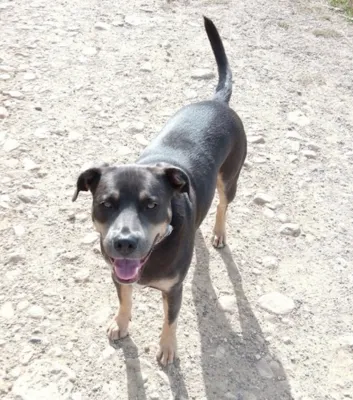 A close-up of a dog's face with soft, gentle eyes, no visible tension, signifying peace and relaxation.
A close-up of a dog's face with soft, gentle eyes, no visible tension, signifying peace and relaxation.
Round/Whale Eyes
Eyes that are round and wide open often indicate that a dog is feeling frightened, stressed, anxious, conflicted, overwhelmed, or trapped. Dogs displaying wide, round eyes commonly have dilated pupils, bloodshot sclera (the white part of the eye), and the whites of their eyes showing – a phenomenon known as “whale eye.” Whale eye typically occurs when a dog’s body and/or head is facing away from something they are looking at, often a fear-inducing stimulus. Their eyes will be turned towards the object, but their body will be leaning or facing away from it, communicating clear discomfort.
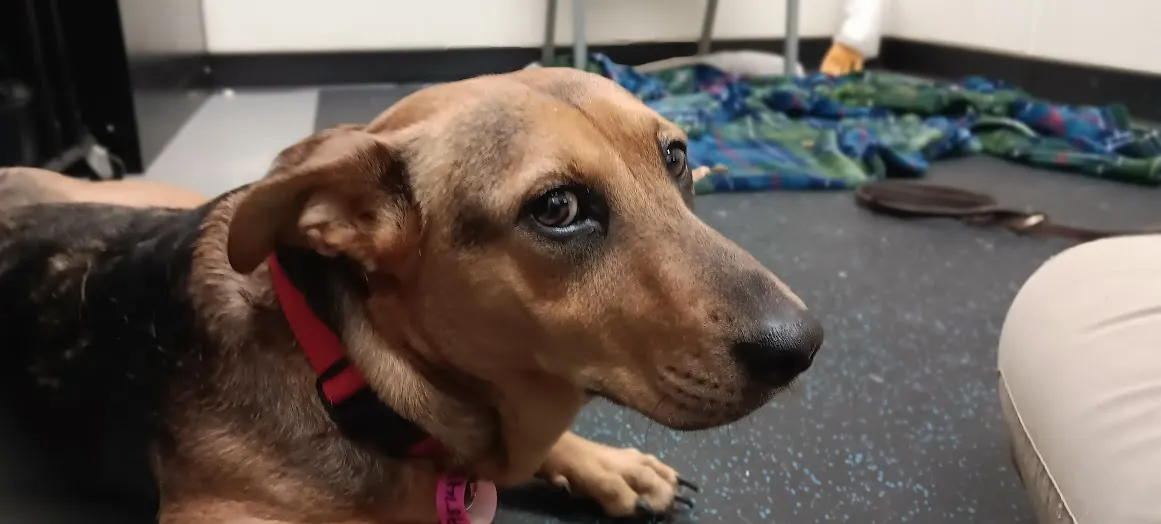 A dog exhibiting "whale eye," where the whites of its eyes are visible as it looks sideways, indicating discomfort and tension.
A dog exhibiting "whale eye," where the whites of its eyes are visible as it looks sideways, indicating discomfort and tension.
In the photo above, the dog is keeping a close eye on the person taking the photo while simultaneously leaning her body away. This is a classic example of “whale eye.” She also communicates discomfort through body tension, backward-facing ears, round eyes, and a closed, tight mouth. These are all yellow light behaviors often accompanied by dilated pupils, a tense and rigid body, pinned back ears, furrowed brows, lip licking, and a low or tucked tail.
Pupils
Observing an animal’s pupils can provide insight into their emotional state. Large pupils in a round, wide eye may indicate a high level of fear, anxiety, stress, and/or arousal. Smaller, “normal” sized pupils typically suggest a state of relaxation, contentment, and/or comfort. As with all body language, context is vital: consider the ambient light, noise levels, and the dog’s overall body posture.
 A dog with wide, round eyes and significantly dilated pupils, indicating high levels of fear, anxiety, or arousal.
A dog with wide, round eyes and significantly dilated pupils, indicating high levels of fear, anxiety, or arousal.
Hard Stare
“Hard” eyes are characterized by an intense, glassy appearance, accompanied by significant pupil dilation and pronounced facial and/or muzzle tension. Dogs displaying hard eyes often make direct, piercing eye contact with what they perceive as a threat. In the image below, this dog’s body and facial muscles are very tense, its mouth is tightly closed, its body weight is shifted forward, and its gaze is fixated on an object.
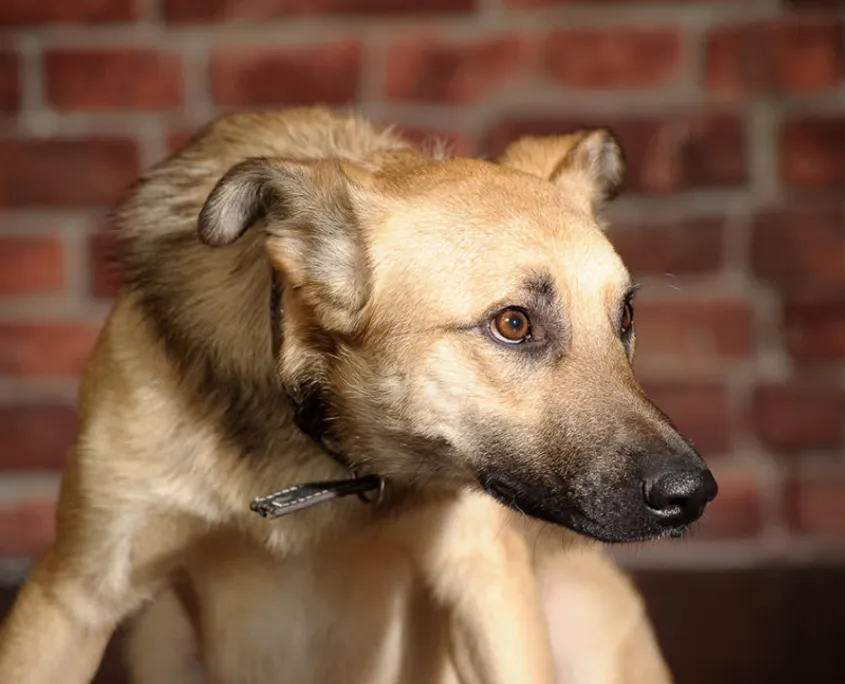 A dog with a fixed, direct, hard stare, rigid body, and forward-shifted weight, indicating a potential threat or aggressive intent.
A dog with a fixed, direct, hard stare, rigid body, and forward-shifted weight, indicating a potential threat or aggressive intent.
Hard eyes and stares are frequently accompanied by other signs of offensive aggression, such as body weight shifted forward, snarling, lunging, snapping, a puckered commissure (corners of the mouth), teeth baring, facial tension, and a flagged, stiff, fast-wagging tail. These behaviors often signal a readiness to engage in biting, fighting, or other offensively aggressive actions if the dog is pushed further beyond its comfort zone or not left alone. These are clear red light behaviors.
Body Posture: What Tension and Relaxation Reveal
Body posture, tension, alignment, and weight distribution offer crucial information about a dog’s feelings. A dog with a loose and wiggly body is usually happy and comfortable. Their bodies will often appear shaped like a “C” or an “S” because their spine, head, and tail are misaligned, reflecting relaxation.
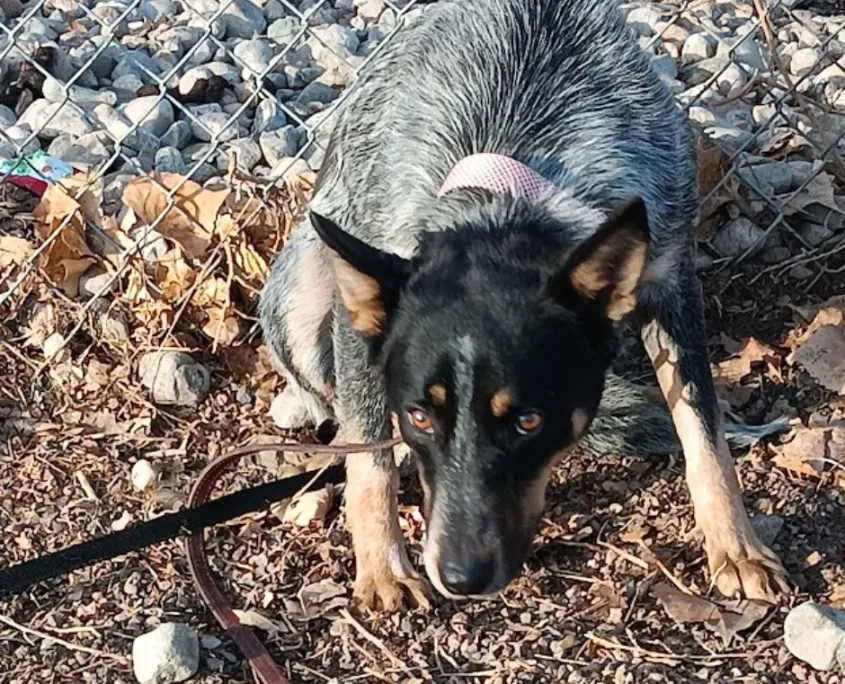 A dog exhibiting a tense and still body posture, with its head lowered toward the ground and weight shifted back, signaling unease.
A dog exhibiting a tense and still body posture, with its head lowered toward the ground and weight shifted back, signaling unease.
Conversely, a dog that is tense, frozen, and rigid is usually frightened or stressed and may behave aggressively if forced to interact without adequate space. Their bodies will often be in a rigid, straight line, with their head, spine, and tail aligned. Fearful dogs frequently lower their heads or entire bodies to the ground and shift their weight onto their hind legs. Offensively aggressive dogs, however, often maintain a square, upright posture and shift their body weight forward. A dog that is frozen and stiff is giving clear red light signs of discomfort, indicating the best course of action is to give them space and leave them alone.
 A dog with bared teeth, a tense, rigid, upright posture, piloerection (hair standing up), and body weight shifted forward, indicating aggression.
A dog with bared teeth, a tense, rigid, upright posture, piloerection (hair standing up), and body weight shifted forward, indicating aggression.
Tails: More Than Just a Wag
A common misconception is that a wagging tail always signifies a happy dog. This is far from the truth. Dogs wag their tails to express a plethora of emotions, including fear, happiness, confliction, appeasement, and aggression. Tails vary in shape and size, and their natural carriage (lower or higher) depends on breed and individual anatomy. Observing the base of a dog’s tail (where it connects to the body) helps determine its true position.
Helicopter or Sweeping Tail
Most dog owners have witnessed tails spinning in circles like a propeller or loosely sweeping back and forth with such force that the dog’s rump or entire body appears to wag. This “helicopter” or “sweeping” wag is truly the only definitive “happy” wag in a dog’s repertoire. While not all happy dogs will display this specific wag, its presence reliably indicates contentment.
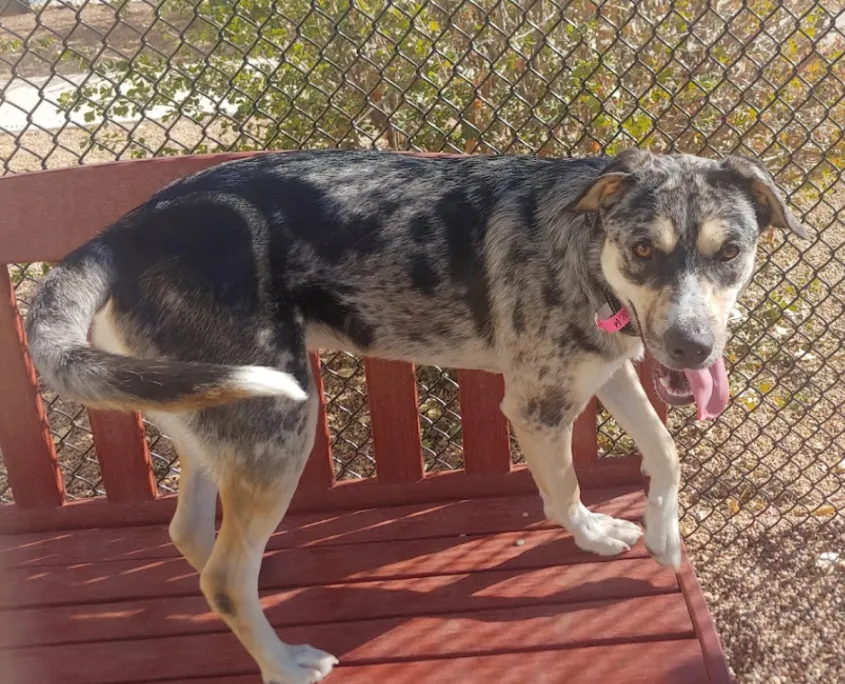 A dog with its tail at a neutral level, sweeping back and forth in wide, loose movements, indicative of a happy and relaxed state.
A dog with its tail at a neutral level, sweeping back and forth in wide, loose movements, indicative of a happy and relaxed state.
Dogs displaying circular or sweeping tail wags often also have soft eyes, loose, wiggly bodies, lolling tongues, wide, smiley mouths, and bouncy, exaggerated movements. These are all green light behaviors.
Tucked Tail
A tucked tail is a universally recognized symbol of fear in dogs. The degree of the tuck directly correlates with the level of negative emotion, with a fully tucked tail expressing the highest levels of fear, anxiety, and stress.
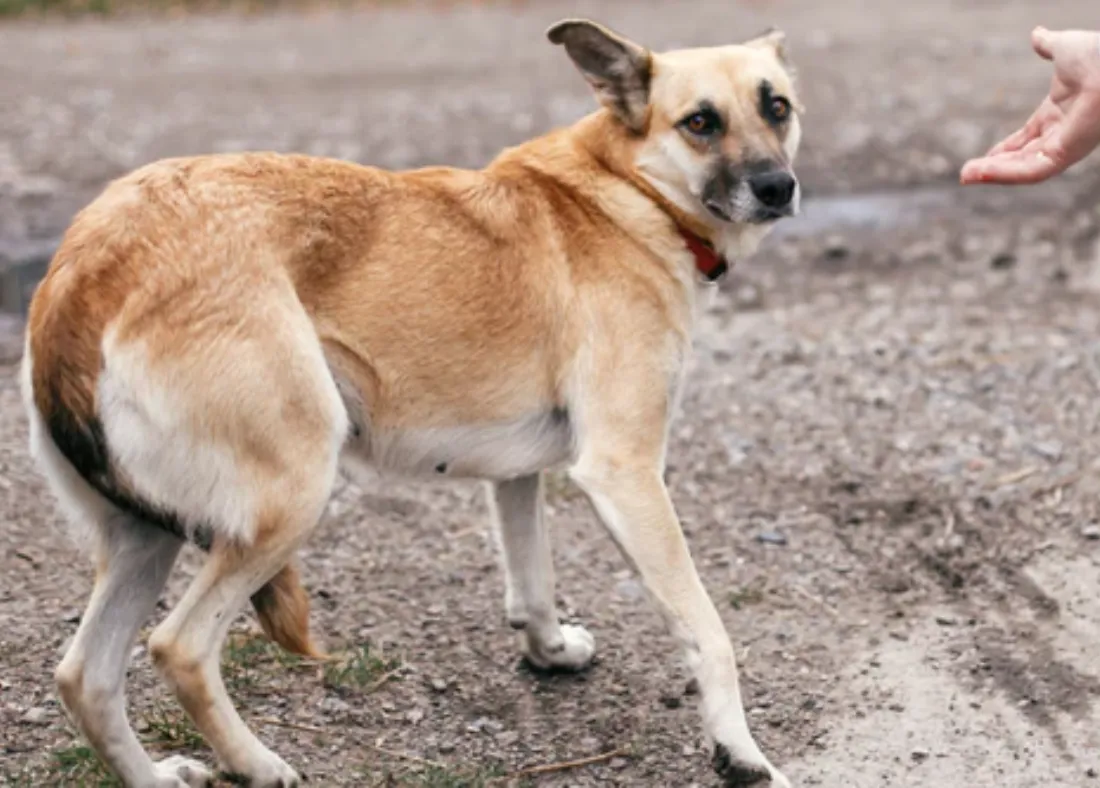 A dog with a fully tucked tail, wide, round eyes, and leaning away from an outstretched hand, clearly signaling fear and discomfort.
A dog with a fully tucked tail, wide, round eyes, and leaning away from an outstretched hand, clearly signaling fear and discomfort.
Partially or fully tucked tails are often accompanied by tense, frozen bodies, pinned back ears, wide round eyes, a furrowed brow, whale or side eye, weight shifted back, and a closed mouth. These are clear yellow light behaviors (sometimes red) that communicate, “I am very uncomfortable/scared/stressed; please don’t come any closer.”
Flagged Tail
A stiff, high, flagged tail with fast, tight wags is commonly a display of aggression or high levels of arousal and alertness. This posture suggests a dog that is ready to react.
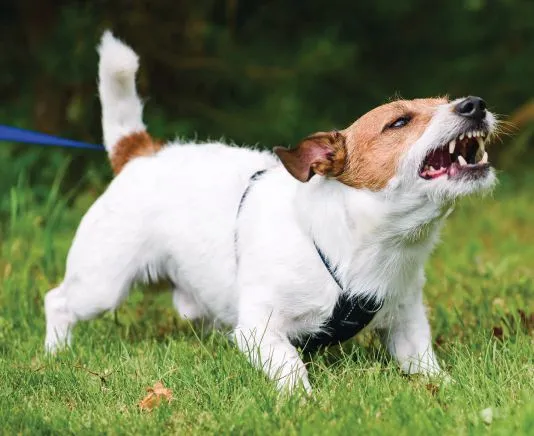 A dog with a high, flagged tail, stiff body, and fixed gaze, indicating alertness, arousal, or potential aggression.
A dog with a high, flagged tail, stiff body, and fixed gaze, indicating alertness, arousal, or potential aggression. 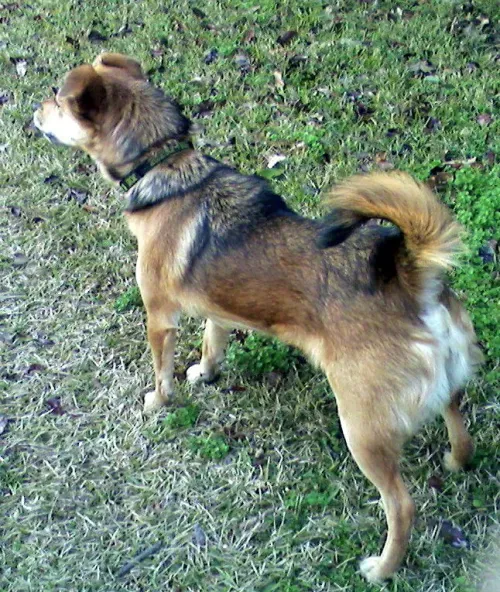 Another dog displaying a high, flagged tail along with forward-shifted weight and a hard gaze, signaling vigilance or aggression.
Another dog displaying a high, flagged tail along with forward-shifted weight and a hard gaze, signaling vigilance or aggression.
Both dogs pictured above have high, flagged tails, indicating a state of heightened arousal or potential aggression. Their weight is shifted forward, and their gaze is fixated and hard. High, flagging tails are often accompanied by stiff, frozen bodies, weight shifted forward, a direct, hard gaze, and piloerection. This can be a yellow or red light signal depending on context and the rest of the dog’s body language.
Mouths: Expressions of Comfort and Stress
A dog’s mouth, much like other body parts, offers a spectrum of communication. Depending on the context and other subtle behaviors, a panting dog could be utterly relaxed, scared, or completely stressed. The same applies to a closed mouth or bared teeth. The position, shape, and tension around a dog’s mouth can reveal much about their inner emotional state. For pet parents interested in exploring diverse interactions with their dogs, even something as simple as to read to your dog man can strengthen their bond and deepen their understanding of each other’s presence.
Panting
There’s a distinct difference between happy, relaxed panting and stress panting. Relaxed panting is often accompanied by a lolling tongue, soft eyes, and a smooth, wrinkle-free face. In contrast, stress panting can be identified by a tense, spatula-shaped tongue, a severely pulled back, V-shaped commissure (corners of the mouth), facial tension, dilated pupils, and excessive drooling.
 A dog on the top left, relaxed with a lolling tongue and soft eyes, compared to two other dogs showing signs of stress panting with tense tongues and wrinkled facial features.
A dog on the top left, relaxed with a lolling tongue and soft eyes, compared to two other dogs showing signs of stress panting with tense tongues and wrinkled facial features. 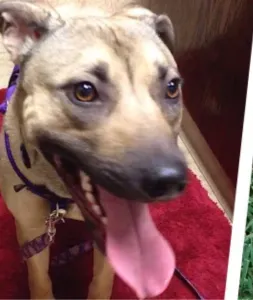 A dog exhibiting stress panting, characterized by a tense, spatula-shaped tongue and visible facial tension.
A dog exhibiting stress panting, characterized by a tense, spatula-shaped tongue and visible facial tension. 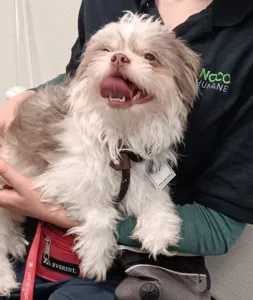 Another example of stress panting in a dog, with a tightly pulled back commissure and facial wrinkles.
Another example of stress panting in a dog, with a tightly pulled back commissure and facial wrinkles.
The dog on the top left is relaxed and content, with a lolling tongue, neutral body, soft eyes, and no facial tension. The other two dogs (top right and bottom) may appear content, but they are actually stressed. Their ears are pinned back, and they are both stress panting, which is often characterized by a spatulate tongue (tense and shaped like a spatula), facial wrinkles/tension, and a tightly pulled back and wrinkled commissure.
Closed Mouths
If you notice a dog panting and then suddenly closing its mouth, pay close attention. This is a strong red light behavior that often occurs just before a bite, signaling an imminent escalation of discomfort.
Lip Licking and Yawning
Dogs who feel uncomfortable, frightened, or stressed may lick their lips and/or yawn frequently. As always, context is key. These behaviors would mean something entirely different if a dog had just woken up from a nap or finished a tasty treat. Look for tension and/or wrinkles on the muzzle or around the corners of the mouth, and pay attention to excessive lip licking, drooling, and yawning. Dogs who are stress panting may also show other signs of distress, such as a tense body, pinned back ears, dilated pupils, and a tucked tail.
Teeth Baring vs. Submissive Grin
People often mistake what is called a “submissive smile or grin” for a snarly display of aggression. However, a submissive grin communicates the exact opposite of aggression. Dogs who grin or smile submissively are trying to convey, “I mean you no harm. I am no threat; please don’t hurt me.” A dog that is baring teeth out of aggression is communicating something entirely different: “I am not happy. Don’t come any closer, or I may have to do something about it!”
 A dog displaying a submissive grin, characterized by a slight upturn of the lips showing front teeth, combined with soft eyes.
A dog displaying a submissive grin, characterized by a slight upturn of the lips showing front teeth, combined with soft eyes.  Another dog with a submissive grin, typically seen with other appeasement signals like a lowered head or body.
Another dog with a submissive grin, typically seen with other appeasement signals like a lowered head or body.
The two dogs above are displaying submissive grins. The dog below is snarling and baring his teeth – a clear warning to stay away!
 A dog snarling with bared teeth, a tense muzzle, and a rigid posture, indicating aggression and a warning to maintain distance.
A dog snarling with bared teeth, a tense muzzle, and a rigid posture, indicating aggression and a warning to maintain distance.
The best way to differentiate between a submissive smile and an aggressive snarl is by observing the rest of the dog’s body. Submissive grins are often accompanied by squinted eyes, a low wagging tail, submissive urination, curving the body, and/or exposing the belly. An aggressive snarl, in contrast, is typically paired with a stiff, rigid body, a hard, glassy stare, and a low growl. It is crucial to understand these distinctions to respond appropriately and safely. The complex emotional landscape of dogs, as seen in behaviors like submissive grins versus aggressive snarls, mirrors the nuanced portrayals in stories like curious incident of the dog in the night time, which highlights the importance of careful observation.
Ears: Subtle Indicators of Emotion
Dogs come in a wide array of shapes and sizes, and their ear types vary significantly based on breed and whether they are cropped. The position of a dog’s ears offers invaluable insights into their emotional state.
Relaxed/Neutral
A dog’s neutral ear position will depend on their anatomy and what is “natural for them.” Relaxed or neutral ears are flexible and soft, resting in their typical position without tension.
Pinned Back
Ears that lay flat against the head are a strong indication of fear, anxiety, and/or stress. On dogs with long, floppy ears, you can often tell they are stressed or frightened because they will pinch in their ear flaps, pulling them closer to the head.
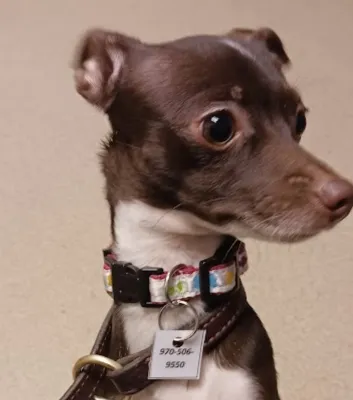 A dog with ears flattened against its head, signifying stress and fear, accompanied by a tense expression and wide eyes.
A dog with ears flattened against its head, signifying stress and fear, accompanied by a tense expression and wide eyes.  Another dog with its ears pinned back, indicating fear or anxiety, along with a tightly closed mouth and side-eye glance.
Another dog with its ears pinned back, indicating fear or anxiety, along with a tightly closed mouth and side-eye glance.
With their ears pinned against the sides of their heads, the dogs pictured above appear stressed and frightened. Beyond their pinned ears, they look tense, have tightly closed mouths, dilated pupils, and are giving side eye. These are clear yellow light signs. This intricate communication system is a key part of the curious incident of the dog in night time, where subtle non-verbal cues are paramount to understanding the world.
Putting It All Together: Strengthening Your Bond
In everyday interactions—whether meeting new dogs, engaging in play, or simply coexisting—it is vital to pay attention to these subtle signs that reveal what your pet is truly feeling. Share this knowledge with family members, children, and friends. This collective awareness helps everyone recognize when your pets are comfortable and safe, or when they need more space and understanding. Your newfound knowledge in decoding the secret language of dogs will ultimately support the furry friends in our community and the people who love them, fostering stronger, safer, and more harmonious relationships.
Further Resources on Dog Behavior
For those wishing to delve deeper into understanding canine behavior and ensuring the well-being of their pets, the following resources are highly recommended.
Dog bite prevention:
- ASPCA Dog Bite Prevention
- AVMA Dog Bite Prevention
- In Spanish: KidsHealth – Prevención de Mordeduras de Perro
Further reading:
- “Positive Training for Aggressive and Reactive Dogs” by Annie Phenix
- “For the Love of a Dog” by Patricia B. McConnell, PhD, CAAB
- “The Other End of the Leash” by Patricia B. McConnell, PhD, CAAB
- “The Cautious Canine; How to Help Dogs Conquer Their Fears” by Patricia B. McConnell, PhD, CAAB
